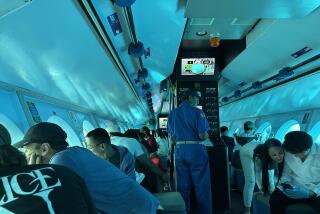‘Unsinkable’ Sub Springs a Leak : Engineering: UC Irvine students test the submersible they have been building since school started last year. Some of the news was encouraging.
- Share via
HUNTINGTON BEACH — As about 30 spectators watched from poolside and from portholes below the water line, the rapidly built Kobyoshi Maru submarine made its maiden voyage Saturday afternoon 7 feet below the water’s surface.
And survived. At least for the first few minutes.
The two-person mini-submarine, designed and built over the past eight weeks by five UC Irvine engineering students as their senior class project, sprang a leak around its large, clear observation bubble and began to take on water.
A few seconds later, large air bubbles escaped en masse from the top entry hatch and made a mad dash for the surface. A crane quickly pulled the sub to the surface.
“Apparently, the acrylic (bubble) failed,” said Ross Blair, 22, one of the submarine’s designers and builders. “Once the water started rushing in, the hatch blew because the (air) pressure needed somewhere to go.”
The students, who have been working almost nonstop for the last several days readying their craft for its test in the million-gallon tank at McDonnell Douglas Space Systems, were disappointed but not depressed.
“It’s something that a little repair and redesign will fix,” Blair said. “We’re excited, though, that the hull was OK.”
A manned test of the submarine will have to wait until after graduation, though, said project leader Scott Emigh, 22.
“You’ve got to expect this kind of thing,” Emigh said shortly after climbing from the 34-foot deep pool and taking off his air tank and other scuba gear.
A videotape of the submarine’s construction, from its start as half-inch steel plates welded together on a loading dock behind UCI’s engineering building to Saturday’s test under water, will be turned in to their professor in lieu of a long report, Emigh said.
The 11-foot-long, bright yellow submarine was designed and built by the students to be capable of diving as deep as 150 feet and operate underwater completely self-contained for more than two hours. Design of the craft started at the beginning of the school year as part of a required senior project in mechanical engineering. In addition to Emigh and Blair, other team members were Mike Kadell, 32, Gil Hurtado, 24, and Dwayne Podd, 22.
Saturday’s test in the huge indoor swimming pool, which was designed to simulate weightlessness for astronauts practicing to build a space station, not only culminated the yearlong effort by the students, it also capped a daylong struggle to conduct the planned manned operation.
“I’ve been up for the last 50 hours,” Hurtado said while the team added more weights to the submarine to persuade the too-buoyant craft to sink below the surface.
Volunteer staff at McDonnell Douglas, including an underwater cameraman to record the test up close, had to dunk the sub four times into the huge pool, each time with more weight attached, before the submarine finally made its first dive.
A five-ton crane held the sub tightly from above during the entire test.
“We’ve got a new name for it,” Emigh’s father, Wayne, said as the crane pulled the sub from the water once again. “The ‘Unsinkable Molly Brown.’ ”
Each time the craft was pulled from the water, the five students swarmed around it to patch newly discovered leaks and add weight.
Although the sub balked at going under the surface at first, Scott Emigh said: “We’re actually pretty happy about that. Half the professors at UCI would walk by and say, ‘This thing is going to sink like a rock.’ ”
Even though a manned test of the Kobyoshi Maru had to be scrapped because of the major leak, the team learned enough during the day to determine that their basic design will work, after repairs.
“It’s something we’re going to make seaworthy, and we’re going to use it,” Emigh vowed after the final test. “We’ve come too far to give it up at this point.”
More to Read
Sign up for Essential California
The most important California stories and recommendations in your inbox every morning.
You may occasionally receive promotional content from the Los Angeles Times.













